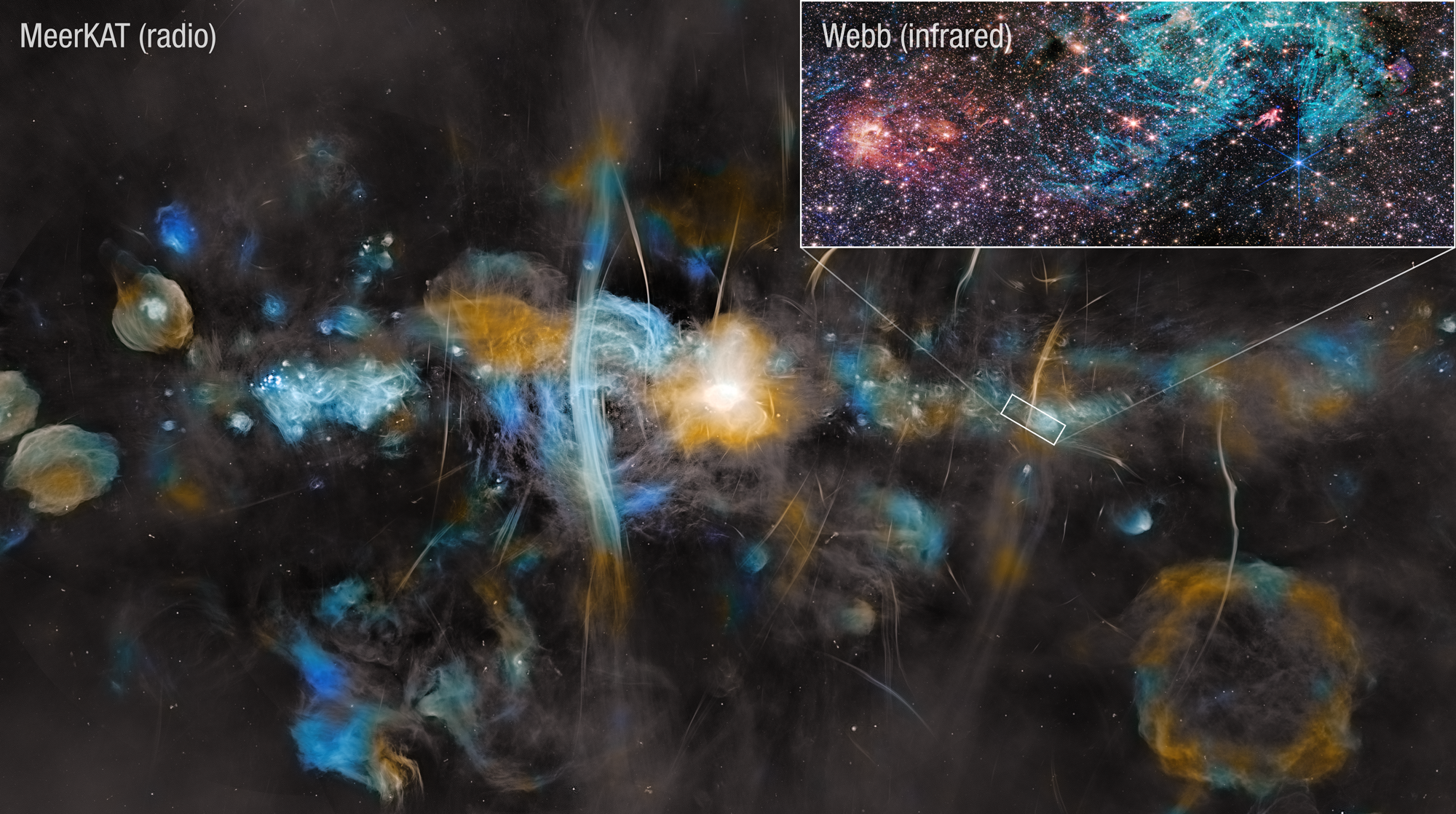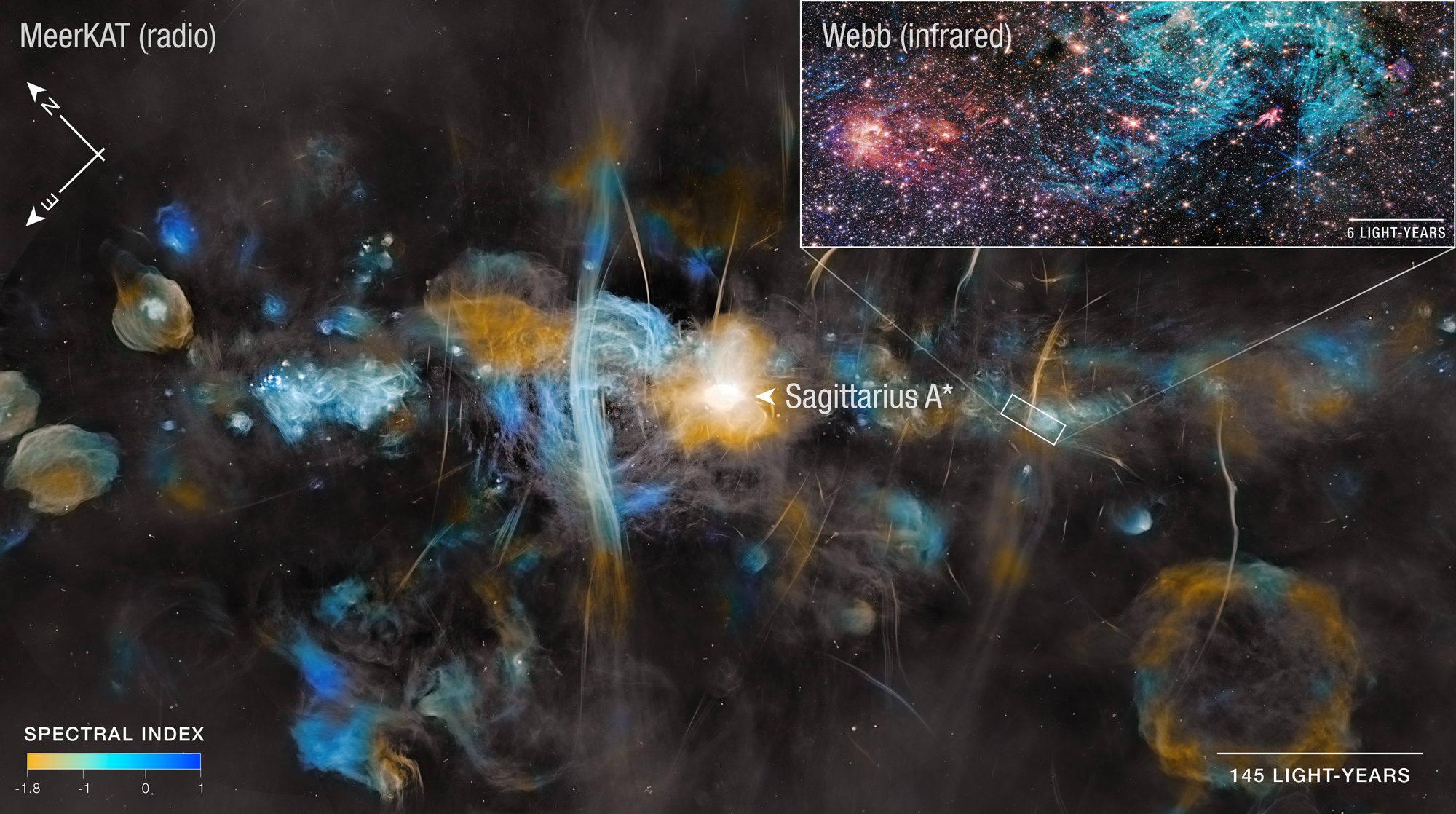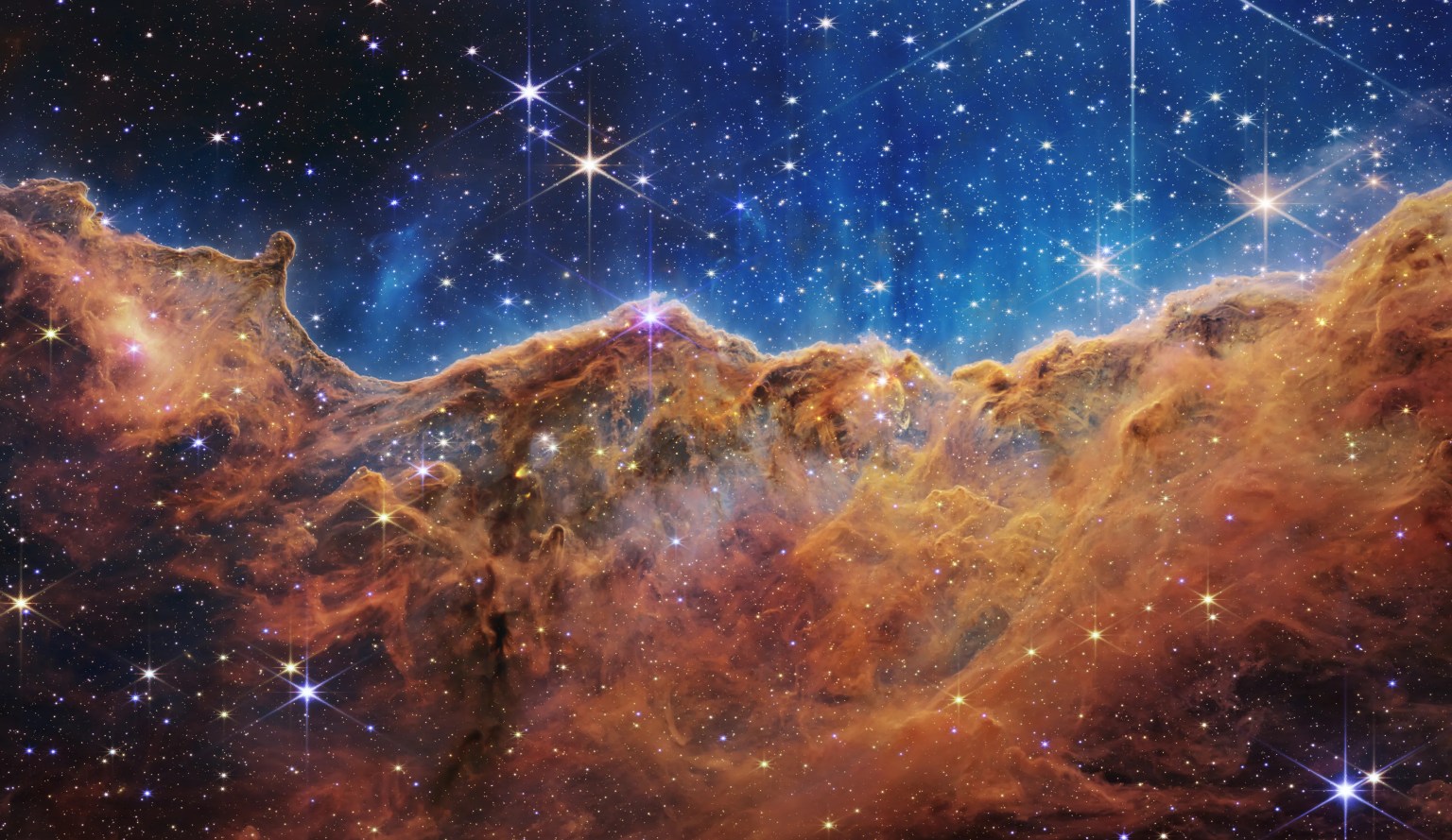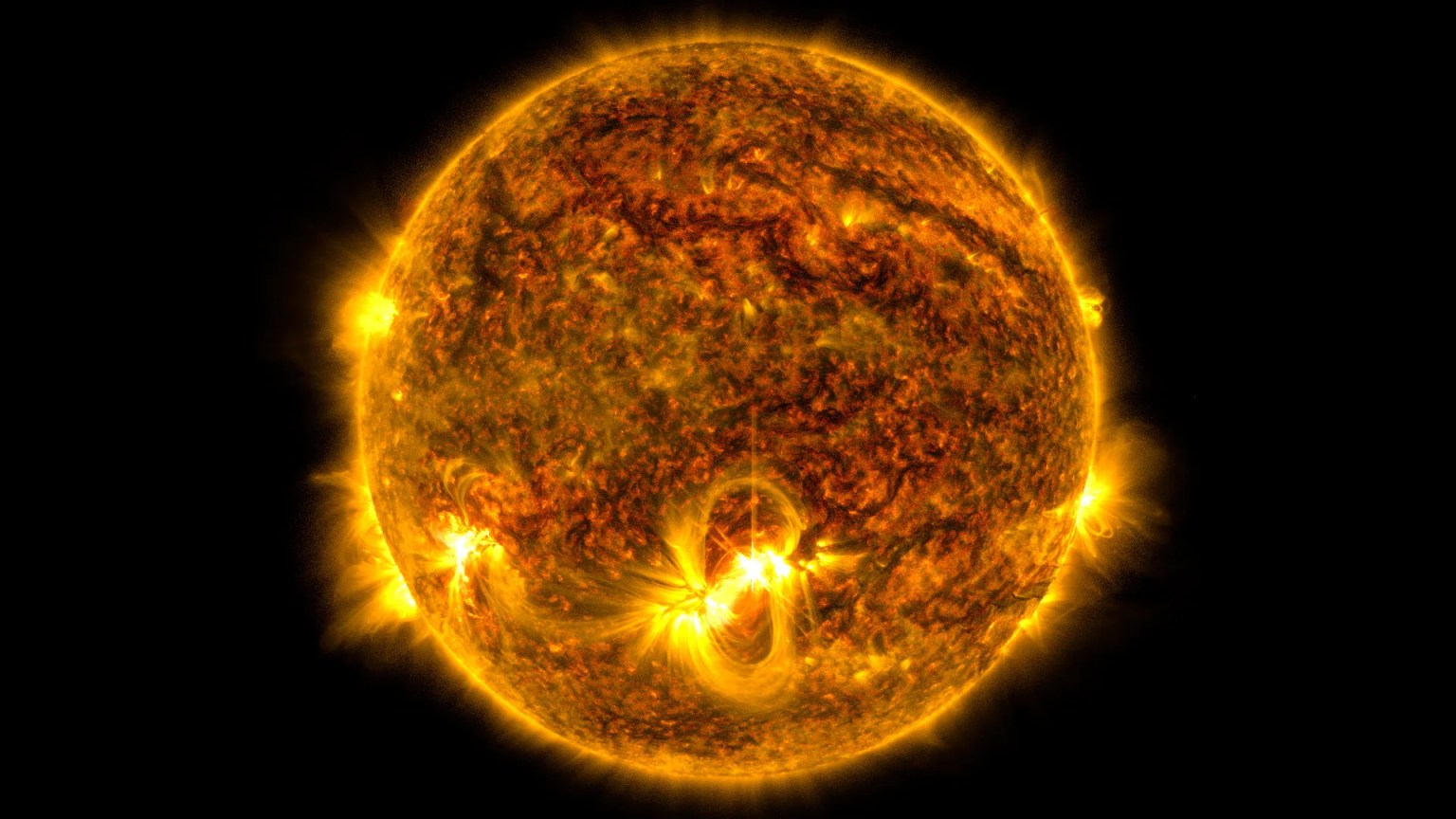NASA Webb Explores Effect of Strong Magnetic Fields on Star Formation

NASA, ESA, CSA, STScI, SARAO, Samuel Crowe (UVA), John Bally (CU), Ruben Fedriani (IAA-CSIC), Ian Heywood (Oxford)
Follow-up research on a 2023 image of the Sagittarius C stellar nursery in the heart of our Milky Way galaxy, captured by NASA’s James Webb Space Telescope, has revealed ejections from still-forming protostars and insights into the impact of strong magnetic fields on interstellar gas and the life cycle of stars.
“A big question in the Central Molecular Zone of our galaxy has been, if there is so much dense gas and cosmic dust here, and we know that stars form in such clouds, why are so few stars born here?” said astrophysicist John Bally of the University of Colorado Boulder, one of the principal investigators. “Now, for the first time, we are seeing directly that strong magnetic fields may play an important role in suppressing star formation, even at small scales.”
Detailed study of stars in this crowded, dusty region has been limited, but Webb’s advanced near-infrared instruments have allowed astronomers to see through the clouds to study young stars like never before.
“The extreme environment of the galactic center is a fascinating place to put star formation theories to the test, and the infrared capabilities of NASA’s James Webb Space Telescope provide the opportunity to build on past important observations from ground-based telescopes like ALMA and MeerKAT,” said Samuel Crowe, another principal investigator on the research, a senior undergraduate at the University of Virginia and a 2025 Rhodes Scholar.
Bally and Crowe each led a paper published in The Astrophysical Journal.
Image A: Milky Way Center (MeerKAT and Webb)

Image B: Milky Way Center (MeerKAT and Webb), Labeled

Using Infrared to Reveal Forming Stars
In Sagittarius C’s brightest cluster, the researchers confirmed the tentative finding from the Atacama Large Millimeter Array (ALMA) that two massive stars are forming there. Along with infrared data from NASA’s retired Spitzer Space Telescope and SOFIA (Stratospheric Observatory for Infrared Astronomy) mission, as well as the Herschel Space Observatory, they used Webb to determine that each of the massive protostars is already more than 20 times the mass of the Sun. Webb also revealed the bright outflows powered by each protostar.
Even more challenging is finding low-mass protostars, still shrouded in cocoons of cosmic dust. Researchers compared Webb’s data with ALMA’s past observations to identify five likely low-mass protostar candidates.
The team also identified 88 features that appear to be shocked hydrogen gas, where material being blasted out in jets from young stars impacts the surrounding gas cloud. Analysis of these features led to the discovery of a new star-forming cloud, distinct from the main Sagittarius C cloud, hosting at least two protostars powering their own jets.
“Outflows from forming stars in Sagittarius C have been hinted at in past observations, but this is the first time we’ve been able to confirm them in infrared light. It’s very exciting to see, because there is still a lot we don’t know about star formation, especially in the Central Molecular Zone, and it’s so important to how the universe works,” said Crowe.
Magnetic Fields and Star Formation
Webb’s 2023 image of Sagittarius C showed dozens of distinctive filaments in a region of hot hydrogen plasma surrounding the main star-forming cloud. New analysis by Bally and his team has led them to hypothesize that the filaments are shaped by magnetic fields, which have also been observed in the past by the ground-based observatories ALMA and MeerKAT (formerly the Karoo Array Telescope).
“The motion of gas swirling in the extreme tidal forces of the Milky Way’s supermassive black hole, Sagittarius A*, can stretch and amplify the surrounding magnetic fields. Those fields, in turn, are shaping the plasma in Sagittarius C,” said Bally.
The researchers think that the magnetic forces in the galactic center may be strong enough to keep the plasma from spreading, instead confining it into the concentrated filaments seen in the Webb image. These strong magnetic fields may also resist the gravity that would typically cause dense clouds of gas and dust to collapse and forge stars, explaining Sagittarius C’s lower-than-expected star formation rate.
“This is an exciting area for future research, as the influence of strong magnetic fields, in the center of our galaxy or other galaxies, on stellar ecology has not been fully considered,” said Crowe.
The James Webb Space Telescope is the world’s premier space science observatory. Webb is solving mysteries in our solar system, looking beyond to distant worlds around other stars, and probing the mysterious structures and origins of our universe and our place in it. Webb is an international program led by NASA with its partners, ESA (European Space Agency) and CSA (Canadian Space Agency).
Downloads
Click any image to open a larger version.
View/Download all image products at all resolutions for this article from the Space Telescope Science Institute.
View/Download the science paper led by Bally from the The Astrophysical Journal.
View/Download the science paper led by Crowe from the The Astrophysical Journal.
Media Contacts
Laura Betz – laura.e.betz@nasa.gov
NASA’s Goddard Space Flight Center, Greenbelt, Md.
Leah Ramsay – lramsay@stsci.edu
Space Telescope Science Institute, Baltimore, Md.
Christine Pulliam – cpulliam@stsci.edu
Space Telescope Science Institute, Baltimore, Md.
Related Information
Read more: press releases about the center of the Milky Way
NASA’s Universe of Learning: ViewSpace Interactive image tour of the center of the Milky Way
Learn more about the Milky Way and Sagittarius Constellation



